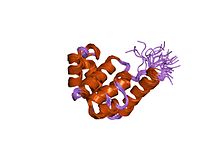DnaB helicase
| Replicative DNA helicase | |
|---|---|
| Identifiers | |
| Symbol | DnaB |
| Entrez | 948555 |
| UniProt | P0ACB0 |
| Other data | |
| EC number | 3.6.1.- |
| DnaB-like helicase N terminal domain | |||||||||
|---|---|---|---|---|---|---|---|---|---|

nmr structure of the n-terminal domain of e. coli Dnab helicase
|
|||||||||
| Identifiers | |||||||||
| Symbol | DnaB | ||||||||
| Pfam | PF00772 | ||||||||
| InterPro | IPR007693 | ||||||||
| SCOP | 1jwe | ||||||||
| SUPERFAMILY | 1jwe | ||||||||
|
|||||||||
| Available protein structures: | |
|---|---|
| Pfam | structures |
| PDB | RCSB PDB; PDBe; PDBj |
| PDBsum | structure summary |
| DnaB-like helicase C terminal domain | |||||||||
|---|---|---|---|---|---|---|---|---|---|
| Identifiers | |||||||||
| Symbol | DnaB_C | ||||||||
| Pfam | PF03796 | ||||||||
| Pfam clan | CL0023 | ||||||||
| InterPro | IPR007694 | ||||||||
| CDD | cd00984 | ||||||||
|
|||||||||
| Available protein structures: | |
|---|---|
| Pfam | structures |
| PDB | RCSB PDB; PDBe; PDBj |
| PDBsum | structure summary |
DnaB helicase is an enzyme in bacteria which opens the replication fork during DNA replication. Although the mechanism by which DnaB both couples ATP hydrolysis to translocation along DNA and denatures the duplex is unknown, a change in the quaternary structure of the protein involving dimerisation of the N-terminal domain has been observed and may occur during the enzymatic cycle. Initially when DnaB binds to dnaA, it is associated with dnaC, a negative regulator. After DnaC dissociates, DnaB binds dnaG.
The N-terminal has a multi-helical structure that forms an orthogonal bundle. The C-terminal domain contains an ATP-binding site and is therefore probably the site of ATP hydrolysis.
In eukaryotes, helicase function is provided by the MCM (Minichromosome maintenance) complex.
The DnaB helicase is the product of the dnaB gene. The helicase enzyme that is produced is a hexamer in E. coli, as well as in many other bacteria. The energy for DnaB activity is provided by NTP hydrolysis. Mechanical energy moves the DnaB into the replication fork, physically splitting it in half.
In E. coli, dnaB is a hexameric protein of six 471-residue subunits, which form a ring-shaped structure with threefold symmetry. During DNA replication, the lagging strand of DNA binds in the central channel of dnaB, and the second DNA strand is excluded. The binding of dNTPs causes a conformational change which allows the dnaB to translocate along the DNA, thus mechanically forcing the separation of the DNA strands.
At least 10 different enzymes or proteins participate in the initiation phase of replication. They open the DNA helix at the origin and establish a prepriming complex for subsequent reactions. The crucial component in the initiation process is the DnaA protein, a member of the AAA+ ATPase protein family (ATPases associated with diverse cellular activities). Many AAA+ ATPases, including DnaA, form oligomers and hydrolyze ATP relatively slowly. This ATP hydrolysis acts as a switch mediating interconversion of the protein between two states. In the case of DnaA, the ATP-bound form is active and the ADP-bound form is inactive.
...
Wikipedia
